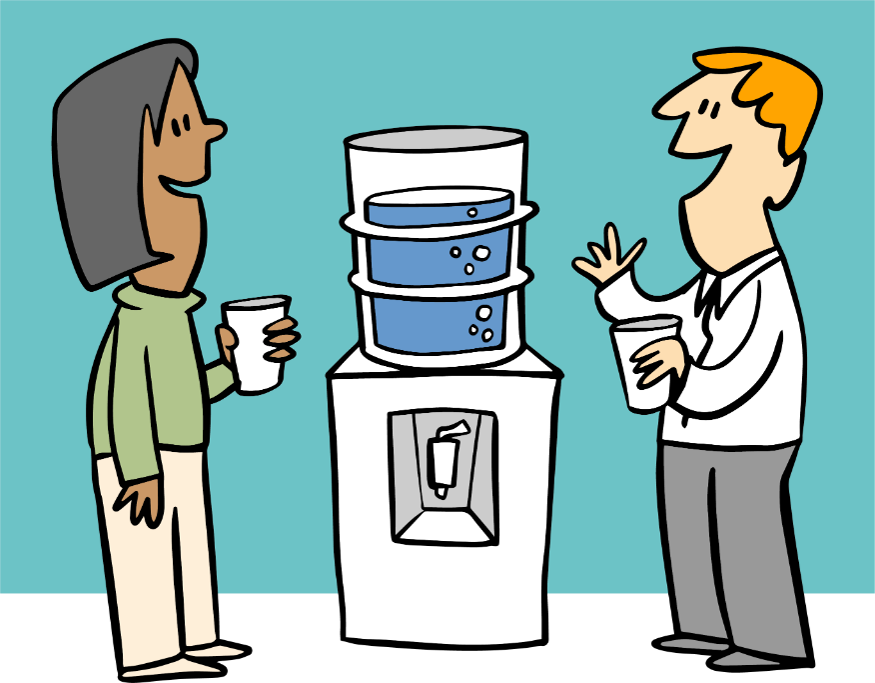Serendipity – worth getting back to the office for, or damaging myth?
I’ve engaged in a couple of conversations recently with our training program participants and online about this strong belief that random encounters at the coffee machine drive valuable communication and innovation.
The loss of serendipity “the occurrence and development of events by chance in a happy or beneficial way” is often used by proponents of working from the office to make people endure the daily commute to a fixed location in the hope of the random exercise of chance.
Let’s imagine that serendipity really happens. Through the sheer chance of you being thirsty at the same time as someone else who is in the same location as you, you meet at the coffee machine. How often do you engage in substantive conversation about what you’re working on with someone who doesn’t already know it pretty well, and how often is it just the social niceties? How often do you choose to sit down and have a detailed conversation with someone after meeting at the coffee machine or water cooler?
Let’s imagine that that does actually happen by chance, and it uncovers a really important piece of information, or sparks a really important idea. Shouldn’t it then be possible to do better than random chance? If it’s important to us, why wouldn’t we organise for it? We wouldn’t have a quality process that relied on people happening to drop by a production line and spot a problem. If things are important in business, then we organise for them.
It’s not difficult to put people together in random configurations and give them time to discuss ideas and things that working on, but we generally don’t do it. In a virtual environment if we think that serendipity is a potential loss, then we need to create these kinds of random connections both individually and collectively and give people the time to have unstructured conversations.
Wouldn’t it then be even better to organise distributed serendipity sessions, as under the” random meeting at the coffee machine” model you are only likely to be exposed to a tiny subset of people who are based in the same office, there on the same day, and felt like a coffee at the same time – this doesn’t sound like a very capable business process, or the best way to engage diverse perspectives.
Similarly, if important communication is only flowing through chance, then this is not a feature of your communication process, it’s a fault. If it’s important, we need to make sure it’s disseminated properly, relying on chance encounter is unlikely to get the communication task done, particularly in a distributed organisation with multiple locations.
Now let’s imagine that serendipity is actually an extremely rare event and not worth us being too concerned about. I’ve encountered a lot of resistance to this idea but not much evidence of where serendipity has really driven value.
People point to stories around innovation driven by the random connection of ideas, there are some interesting examples on this Wikipedia entry Nearly all of the examples are about individual serendipity where a person working alone spotted an interesting but tangential fact. They weren’t generally driven by people interacting with other individuals or discussing ideas.
On a similar note, research has been clear for decades that the generation of ideas is best done by individuals working alone, groups actually generate fewer raw ideas when working collectively. Collective brainstorming is a myth that we cling to despite the evidence. Groups, however, may be better at evaluating and developing ideas so the best idea generation and evaluation processes usually start with individual ideation. When was the last time you had your best idea in a meeting rather than in the shower or on a walk?
As remote and hybrid working becomes the norm and as teams span multiple locations even when people are working in their different offices, we have three main options
- don’t worry about serendipity and the water cooler moments, they were never of much value anyway
- get people back into the office in the hope that chance will create random communication and innovation
- organise for more active connections by bringing a broader constituency of people together in a format that enables them to share ideas and spark cooperation – in most larger organisations this probably means in some form of virtual context
What do you think, is serendipity a myth? Is it something worth forcing people back into the office for, or do we need to organise differently to do better than chance?

Explore our training programs to see how we can help.
Agile & Digital Training Matrix Management Training People and purpose Training Virtual Teams TrainingEducate yourself further with a few more or our online insights:
30 years of experience learning with a range of world class clients
We work with a wide range of clients from global multinationals to recent start-ups. Our audiences span all levels, from CEOs to operational teams around the world. Our tools and programs have been developed for diverse and demanding audiences.

Tailored training or off the shelf modules for your people development needs
We are deep content experts in remote, virtual and hybrid working, matrix management and agile & digital leadership. We are highly flexible in how we deliver our content and ideas. We can tailor content closely to your specific needs or deliver off the shelf bite sized modules based on our existing IP and 30 years of training experience.
For more about how we deliver our keynotes, workshops, live web seminars and online learning.